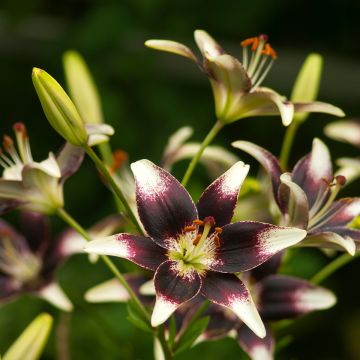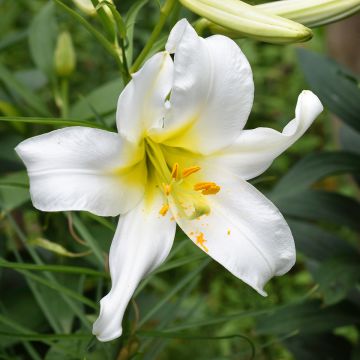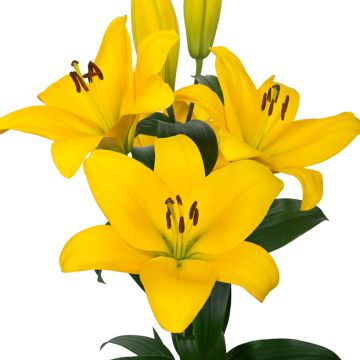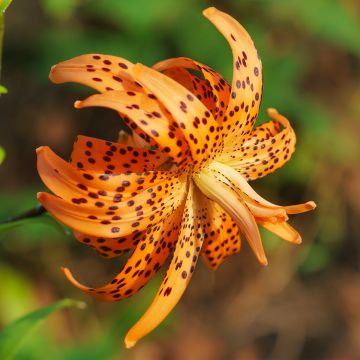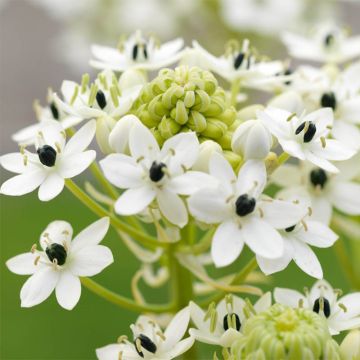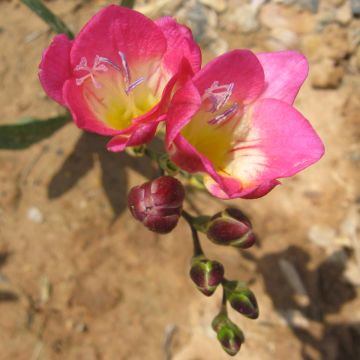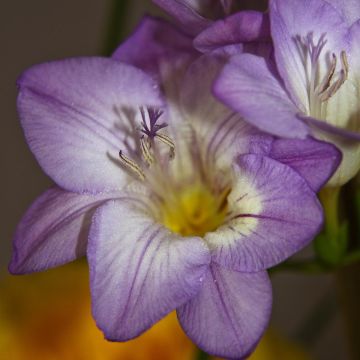

Lilium (x) longiflorum 'Crosscourt' Butterfly Luna® - Easter Lily
Lilium (x) longiflorum 'Crosscourt' Butterfly Luna® - Easter Lily
Lilium (x) longiflorum 'Crosscourt' Butterfly Luna®
Easter Lily, Longiflorum Lily
This item cannot be shipped to the selected country
Delivery charge from €5.90
More information
Schedule delivery date,
and select date in basket
This plant carries a 6 months recovery warranty
More information
We guarantee the quality of our plants for a full growing cycle, and will replace at our expense any plant that fails to recover under normal climatic and planting conditions.
From €5.90 for pickup delivery and €6.90 for home delivery
Express home delivery from €8.90.
Does this plant fit my garden?
Set up your Plantfit profile →
Description
The Lilium 'Crosscourt' 'Butterfly Luna' is a hybrid of longiflorum and Asian lilies that brightens floral compositions with its bright yellow colour and generous shape. This cultivar, of medium to large size, bears numerous floral buds, ensuring a long flowering period. Its vivid and luminous colour is ideal for enhancing bouquets. Without pollen and speckles, its double flower has a sleek and refined look.
The 'Butterfly Luna' Lily is a recent Dutch horticultural creation. It is a bulbous plant with deciduous vegetation from the lily family. This cultivar is part of a group of hybrids resulting from, among others, Asian species such as Lilium longiflorum and L. formosanum. These varieties are prized in floristry for their large, brightly coloured flowers that last several days in a vase. At full bloom, 'Butterfly Luna' will reach between 1 m and 1.30 m in height, and its vegetation will spread over time, with bulbs producing numerous bulblets through vegetative propagation. Each floral stem bears 7 to 9 double flowers measuring approximately 15 cm in diameter, facing upwards. Their colour is a bright and pure yellow. At the heart of each flower are yellow stamens with mahogany anthers that are devoid of pollen. The long, glossy leaves, dark green in colour, are narrow and lanceolate, with parallel veins running through them. The vegetation dries out in autumn, while the bulb goes into dormancy. The bulbs are reserve organs with fleshy, overlapping scales.
Hybrid longiflorum lilies such as 'Butterfly Luna' bloom after 10 or 11 weeks of cultivation, they can be "forced" by planting them early in the season in a veranda or a warm room. The soil they are planted in should remain moist throughout the growth and flowering period.
In a flowerbed or bouquet, you can pair 'Crosscourt' with the Shasta Daisy 'Wirral Supreme', the blue Delphinium 'Blauwal', and the decorative dahlia 'Babylon Bronze', for example. Winter protection, in the form of a thick mulch, is not unnecessary in very cold regions. Lilies appreciate having their feet in the shade, with neighbouring plants helping to prevent the stems from bending in the wind.
Report an error about the product description
Plant habit
Flowering
Foliage
Botanical data
Lilium
(x) longiflorum
'Crosscourt' Butterfly Luna®
Liliacées
Easter Lily, Longiflorum Lily
Cultivar or hybrid
Other Lilies A to Z
Planting and care
The Lilium 'Butterfly Luna' prefers soils that are moist and rich in humus, it does not appreciate very dry, poor, or poorly drained and very clayey soils. It is a variety that can withstand frosts of around -17°C. You will plant it in the sun, in spring or early autumn, burying the bulbs 15 cm deep (about two to three times the size of the bulb) in a pocket of soil mixed with leaf compost. Surround them with a pocket of sand to prevent rot and slug attacks, while allowing them to grow more easily. Mark the planting location, as the vegetation only starts in April.
Growing in a deep pot allows the plant to overwinter in an unheated, cool, but frost-free room. This method also allows for "forcing" the bulb, meaning advancing the vegetation recovery and flowering period. To do this, the pot will be stored in a very bright and slightly heated room before the beginning of spring.
When the stems reach 30 cm high, discreetly stake them. If red insects appear, treat them immediately; they are lily beetles whose larvae can devour all the leaves. The most effective method is to catch them by hand, but be careful, they drop as soon as they are touched, so put a box underneath. After flowering, it is useful to cut the faded flowers halfway to keep the bed beautiful during the summer.
Planting period
Intended location
Care
This item has not been reviewed yet - be the first to leave a review about it.
Fragrant flowering bulbs
Haven't found what you were looking for?
Hardiness is the lowest winter temperature a plant can endure without suffering serious damage or even dying. However, hardiness is affected by location (a sheltered area, such as a patio), protection (winter cover) and soil type (hardiness is improved by well-drained soil).

Photo Sharing Terms & Conditions
In order to encourage gardeners to interact and share their experiences, Promesse de fleurs offers various media enabling content to be uploaded onto its Site - in particular via the ‘Photo sharing’ module.
The User agrees to refrain from:
- Posting any content that is illegal, prejudicial, insulting, racist, inciteful to hatred, revisionist, contrary to public decency, that infringes on privacy or on the privacy rights of third parties, in particular the publicity rights of persons and goods, intellectual property rights, or the right to privacy.
- Submitting content on behalf of a third party;
- Impersonate the identity of a third party and/or publish any personal information about a third party;
In general, the User undertakes to refrain from any unethical behaviour.
All Content (in particular text, comments, files, images, photos, videos, creative works, etc.), which may be subject to property or intellectual property rights, image or other private rights, shall remain the property of the User, subject to the limited rights granted by the terms of the licence granted by Promesse de fleurs as stated below. Users are at liberty to publish or not to publish such Content on the Site, notably via the ‘Photo Sharing’ facility, and accept that this Content shall be made public and freely accessible, notably on the Internet.
Users further acknowledge, undertake to have ,and guarantee that they hold all necessary rights and permissions to publish such material on the Site, in particular with regard to the legislation in force pertaining to any privacy, property, intellectual property, image, or contractual rights, or rights of any other nature. By publishing such Content on the Site, Users acknowledge accepting full liability as publishers of the Content within the meaning of the law, and grant Promesse de fleurs, free of charge, an inclusive, worldwide licence for the said Content for the entire duration of its publication, including all reproduction, representation, up/downloading, displaying, performing, transmission, and storage rights.
Users also grant permission for their name to be linked to the Content and accept that this link may not always be made available.
By engaging in posting material, Users consent to their Content becoming automatically accessible on the Internet, in particular on other sites and/or blogs and/or web pages of the Promesse de fleurs site, including in particular social pages and the Promesse de fleurs catalogue.
Users may secure the removal of entrusted content free of charge by issuing a simple request via our contact form.
The flowering period indicated on our website applies to countries and regions located in USDA zone 8 (France, the United Kingdom, Ireland, the Netherlands, etc.)
It will vary according to where you live:
- In zones 9 to 10 (Italy, Spain, Greece, etc.), flowering will occur about 2 to 4 weeks earlier.
- In zones 6 to 7 (Germany, Poland, Slovenia, and lower mountainous regions), flowering will be delayed by 2 to 3 weeks.
- In zone 5 (Central Europe, Scandinavia), blooming will be delayed by 3 to 5 weeks.
In temperate climates, pruning of spring-flowering shrubs (forsythia, spireas, etc.) should be done just after flowering.
Pruning of summer-flowering shrubs (Indian Lilac, Perovskia, etc.) can be done in winter or spring.
In cold regions as well as with frost-sensitive plants, avoid pruning too early when severe frosts may still occur.
The planting period indicated on our website applies to countries and regions located in USDA zone 8 (France, United Kingdom, Ireland, Netherlands).
It will vary according to where you live:
- In Mediterranean zones (Marseille, Madrid, Milan, etc.), autumn and winter are the best planting periods.
- In continental zones (Strasbourg, Munich, Vienna, etc.), delay planting by 2 to 3 weeks in spring and bring it forward by 2 to 4 weeks in autumn.
- In mountainous regions (the Alps, Pyrenees, Carpathians, etc.), it is best to plant in late spring (May-June) or late summer (August-September).
The harvesting period indicated on our website applies to countries and regions in USDA zone 8 (France, England, Ireland, the Netherlands).
In colder areas (Scandinavia, Poland, Austria...) fruit and vegetable harvests are likely to be delayed by 3-4 weeks.
In warmer areas (Italy, Spain, Greece, etc.), harvesting will probably take place earlier, depending on weather conditions.
The sowing periods indicated on our website apply to countries and regions within USDA Zone 8 (France, UK, Ireland, Netherlands).
In colder areas (Scandinavia, Poland, Austria...), delay any outdoor sowing by 3-4 weeks, or sow under glass.
In warmer climes (Italy, Spain, Greece, etc.), bring outdoor sowing forward by a few weeks.





































